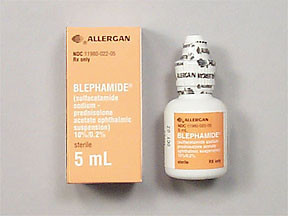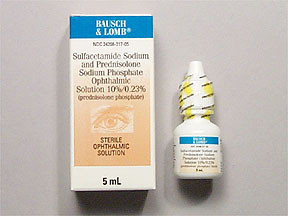SULFACETAMIDE/PREDNISOLONE - OPHTHALMIC SUSPENSION
PHONETIC PRONUNCIATION: (SUL-fa-SEET-a-mide/pred-NIS-oh-loan)
COMMON BRAND NAME(S): Blephamide, Vasocidin
GENERIC NAME(S): sulfacetamide sodium/prednisolone acetate
Uses
USES: This medication is used to prevent or treat eye infections and to treat swelling in the eye. This product contains an antibiotic (sulfacetamide) that stops the growth of bacteria and a corticosteroid (prednisolone) that reduces inflammation. This medication treats only bacterial eye infections. It will not work for other types of eye infections. Unnecessary use or overuse of any antibiotic can lead to its decreased effectiveness.
How to use SULFACETAMIDE/PREDNISOLONE - OPHTHALMIC SUSPENSION
HOW TO USE: To apply eye drops, wash your hands first. Shake this suspension well before each dose. To avoid contamination, do not touch the dropper tip or let it touch your eye or any other surface. Before using this product, check it visually. Do not use if it has darkened in color. Do not wear contact lenses while you are using this medicine. Sterilize contact lenses according to manufacturer's directions and check with your doctor before using them. Tilt your head back, look upward and pull down the lower eyelid to make a pouch. Hold the dropper directly over your eye and place one drop into it. Look downward and gently close your eyes for 1 to 2 minutes. Place one finger at the corner of your eye (near the nose) and apply gentle pressure. This will prevent the medication from draining out. Try not to blink and do not rub your eye. Repeat these steps for your other eye if so directed, and if your dose is for more than 1 drop. Apply as often as directed by your doctor. Do not rinse the dropper. Replace the dropper cap after each use. If you are using another kind of eye medication (e.g., drops or ointments), wait at least 5 minutes before applying other medications. Use eye drops before eye ointments to allow the eye drops to enter the eye. Use this medication regularly in order to get the most benefit from it. Continue using it for the full time prescribed even if symptoms disappear after a few days. Stopping the medication too early may allow bacteria to continue to grow, which may result in a relapse of the infection. Do not use this medication for longer than prescribed. If you use it regularly for an extended period of time, do not suddenly stop using it without consulting your doctor. Your dosage may need to be gradually decreased. Inform your doctor if your condition does not improve after 2 days.
Side Effects
Precautions
Interactions
Overdose
Images
Reviews
Faq for SULFACETAMIDE/PREDNISOLONE - OPHTHALMIC SUSPENSION
Sulfacetamide/Prednisolone Ophthalmic Suspension is commonly used to treat eye infections and inflammation caused by certain bacteria or allergies.
This medication works by preventing the growth and spread of bacteria in the eyes, while the prednisolone reduces inflammation and relieves symptoms such as redness, itching, and swelling.
You should carefully follow the instructions provided by your doctor or pharmacist. Typically, the recommended dosage is one or two drops into the affected eye(s) 2 to 4 times daily. Shake the bottle well before each use and avoid touching the dropper tip to any surface to prevent contamination.
Like any medication, Sulfacetamide/Prednisolone Ophthalmic Suspension may cause side effects. The most common ones include temporary stinging or burning sensation upon application, increased sensitivity to light, blurred vision, and dry eyes. However, these side effects are usually mild and go away on their own. If you experience severe or persistent side effects, contact your healthcare provider.
Yes, this medication can be used in children, but it should be used with caution and under the guidance of a healthcare professional.
It is generally recommended to avoid wearing contact lenses while using this medication. Wait at least 15 minutes after applying the eye drops before inserting your contact lenses. Consult with your eye doctor for further guidance.
The duration of treatment may vary depending on the specific condition being treated. It is important to complete the full course of treatment as prescribed by your doctor, even if your symptoms improve before the treatment is finished.
It is advisable to consult with your healthcare provider before using this medication if you are pregnant, planning to become pregnant, or breastfeeding. They can determine the potential risks and benefits for you and provide appropriate guidance.
If you miss a dose, apply it as soon as you remember. However, if it is close to the time for your next dose, skip the missed dose and continue with your regular dosing schedule. Do not double the dose to make up for a missed one.
Disclaimer
IMPORTANT: HOW TO USE THIS INFORMATION: This is a summary and does NOT have all possible information about this product. This information does not assure that this product is safe, effective, or appropriate for you. This information is not individual medical advice and does not substitute for the advice of your health care professional. Always ask your health care professional for complete information about this product and your specific health needs.



No Reviews Yet